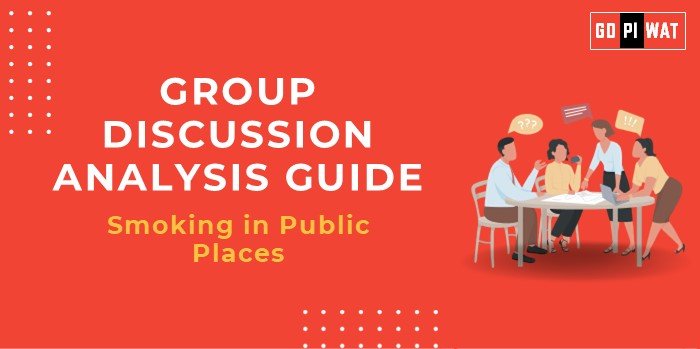📋 Group Discussion Analysis Guide
🌐 Introduction to Smoking in Public Places
Context: Smoking in public places remains a controversial issue, affecting public health, the environment, and individual rights globally. Governments and health organizations are increasingly concerned about the harm caused by secondhand smoke to non-smokers and the associated societal costs.
Background: Public smoking bans were initiated by several countries in the late 20th century, motivated by research linking secondhand smoke exposure to various health risks. As of recent years, the World Health Organization (WHO) continues to advocate for strict regulations in public smoking to safeguard public health.
📊 Quick Facts and Key Statistics
- 🚭 Secondhand Smoke: According to the WHO, 1.2 million people die annually due to exposure to secondhand smoke, highlighting the critical health risks posed to non-smokers.
- 💸 Economic Burden: Smoking-related healthcare costs exceed $300 billion annually in the U.S. alone, showcasing the economic impact of smoking.
- 🌍 Global Bans: Over 80 countries have implemented smoking bans in public places as part of comprehensive tobacco control strategies.
- 👶 Youth Exposure: Research indicates that children exposed to secondhand smoke are 20-30% more likely to suffer from respiratory illnesses, underscoring the need for protection in shared spaces.
🧑🤝🧑 Stakeholders and Their Roles
- 🏛️ Government Bodies: Responsible for implementing and enforcing public smoking bans and health policies.
- ⚕️ Healthcare Organizations: Advocate for bans due to smoking’s health impact, conducting studies on public health effects and raising awareness.
- 🍴 Businesses: Particularly restaurants, bars, and cafes, often have mixed reactions to bans, with some concerned about customer loss.
- 👥 Citizens/Non-Smokers: Benefit directly from reduced secondhand smoke exposure in public areas, supporting the demand for cleaner air in public spaces.
🎯 Achievements and Challenges
✨ Achievements
- 💉 Reduced Health Risks: Countries with bans report reduced hospital admissions for smoking-related illnesses.
- 📣 Increased Public Awareness: Bans have raised awareness of smoking risks, decreasing smoking rates in younger populations.
- 🌬️ Improved Air Quality: Smoke-free public places lead to cleaner air in shared environments, benefiting public health.
- 🏆 Case Study – Ireland: Ireland’s smoking ban led to a 13% decrease in smoking rates within a year, demonstrating significant public health benefits.
⚠️ Challenges
- 🛠️ Enforcement Issues: Ensuring compliance can be difficult, especially in densely populated areas.
- 💵 Economic Pushback: Businesses, especially in the hospitality sector, sometimes report a loss of smoking customers.
- 🌍 Cultural Resistance: In regions where smoking is socially ingrained, bans face resistance, limiting their effectiveness.
Global Comparisons: The UK, Canada, and New Zealand have established successful public smoking bans, while some Asian countries face challenges due to cultural norms and high smoking rates.
📖 Structured Arguments for Discussion
- ✅ Supporting Stance: “Banning smoking in public places is essential to protect non-smokers from health risks and reduce healthcare costs associated with smoking-related illnesses.”
- ❌ Opposing Stance: “Restricting smoking infringes on personal freedom, potentially affecting businesses that rely on smoking clientele.”
- ⚖️ Balanced Perspective: “While public health protection is paramount, designated smoking areas could offer a compromise, respecting both public health concerns and individual freedom.”
💡 Effective Discussion Approaches
- 🚀 Opening Approaches:
- 📊 Statistical Impact: “With secondhand smoke causing over 1 million deaths annually, the need for smoke-free public areas becomes clear.”
- 🌎 Cultural Lens: “Countries with public smoking bans, like the UK, have significantly improved public health, showing a positive impact that can be replicated elsewhere.”
- 🏆 Case Study Reference: “Ireland’s early adoption of a smoking ban led to a dramatic decrease in smoking rates, benefiting the nation’s overall health.”
- 🛠️ Counter-Argument Handling:
- If facing economic concerns, suggest designated smoking zones to minimize business impact.
- Acknowledge cultural challenges but emphasize successful examples from similar societies.
📊 Strategic Analysis of Strengths and Weaknesses
- 💪 Strengths: Health benefits, reduced healthcare costs, cleaner public environments.
- 🤕 Weaknesses: Enforcement challenges, cultural resistance, potential impact on certain businesses.
- 🚀 Opportunities: Public awareness campaigns, designated smoking areas, tourism appeal.
- ⚠️ Threats: Pushback from tobacco industry, non-compliance in high-smoking regions.
🎓 Connecting with B-School Applications
- Real-World Applications: Policy analysis, consumer behavior research, and healthcare management are relevant to B-school projects.
- Sample Interview Questions:
- “What are the pros and cons of banning smoking in public places?”
- “How can businesses balance public health and customer satisfaction?”
- Insights for B-School Students: Understanding public health policy, ethical implications of business practices, and regulatory challenges are key for future leaders.


